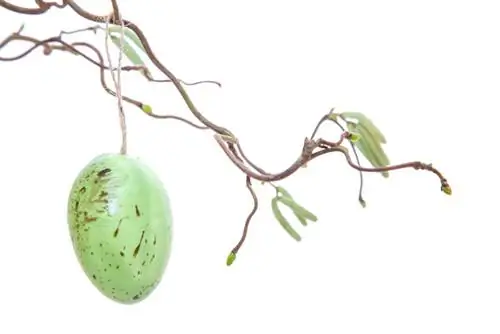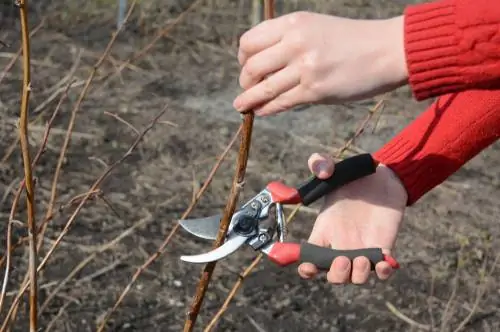- Author admin [email protected].
- Public 2023-12-16 16:46.
- Last modified 2025-01-23 11:21.
In view of boxwood borers, boxwood shoot dieback and other problems, many garden owners decide to give up the seemingly endless fight and remove the boxwood. However, this is often easier said than done, especially if the book is many years or even decades old.

How can I permanently remove a boxwood?
To completely remove a boxwood, saw off the above-ground parts and dig up the roots or prevent the roots from sprouting by covering the area, lowering the pH and cutting off new shoots. Dispose of diseased plants with household waste.
Roots are difficult to remove
The boxwood is a shallow-rooted tree, so you rarely have to dig deeper than about 60 centimeters to remove it. However, the plant develops a very widely branched root system, with the individual strands becoming very thick and strong as it ages. In particular, tearing out boxwood hedges is difficult because the roots of the individual plants are intertwined and can hardly be separated from each other. The use of an excavator is particularly important for older and/or long hedges, as you can hardly remove them with muscle power. Saw off the above-ground parts of the plant before digging out the roots.
How to prevent the boxwood from sprouting again
If removing the roots is too much work for you, you can simply leave them in the ground. Of course, this only works if you take appropriate measures at the same time to prevent the box from sprouting again. In addition, replanting the area can be problematic because the roots are close to the surface. Furthermore, after an infestation with some highly infectious diseases, soil replacement is recommended to avoid reinfection. If you still want the roots to stay in place, you can prevent them from sprouting with these measures:
- Cover the area with an opaque film for a few weeks.
- Fertilize the area with ericaceous fertilizer or fill up ericaceous soil.
- This lowers the pH value of the soil, which boxwood doesn't like at all.
- Keep cutting off new shoots.
- Be persistent, then the roots will die after a while due to the lack of supply.
Be sure to apply a new layer of topsoil so that you can then replant the area.
Dispose of boxwood correctly
He althy boxwood - well chopped and mixed with lawn clippings - can safely be used as mulching material or thrown into the compost. However, due to the risk of infection, diseased plants may be disposed of with household or residual waste in order to avoid the further spread of dangerous diseases.
Tip
You don't necessarily have to tear out he althy boxwood, you can also carefully dig it up and move it - or give it away to interested garden owners.






